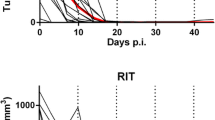Summary
The present studies showed that nude mice xenotransplanted with L5222 leukemia responded as did syngeneic BD IX rats to low doses of mafosfamide or cyclophosphamide. Unlike rats, nude mice rarely showed resistance to a second tumor challenge. The observation that concurrent treatment of rats with cyclosporin A did not alter the rate of survival clearly indicated a T-cell-independent mechanism of tumor defense. The incidence of lung colonies from i. v. injected Lewis lung-tumor cells could be enhanced by a high-dose pretreatment with mafosfamide or cyclophosphamide, whereas pretreatment at low doses was inhibitory. Since identical experiments carried out in NK-cell-deficient C57Bl/6 “beige” mice did not show such an effect, NK cells appeared to represent a possible effector cell in oxazaphosphorine-mediated antitumor effects. This assumption was further supported by the fact that enhanced NK cell activity could be observed in the 51Cr release assay using spleen cells from mafosfamide-treated L5222-bearing rats. The transplantation of the unrelated syngeneic ovarian carcinoma OV-342 to animals that had previously been cured of L5222 leukemia did not lead to the rejection of this tumor. This indicates that a specific resistance against L5222 leukemia had developed. In contrast, a T-cell-dependent antitumor effect was demonstrated for mafosfamide in the MOPC-315 mouse plasmocytoma. Therefore, we conclude that the effector cell for tumor rejection depends on the type of tumor. This, of course, does not exclude a common target cell for the immunopharmacological activity of oxazaphosphorines.
Similar content being viewed by others
References
Barker E, Mokyr MB (1986) Specificity of the generation and expression of enhanced antitumor cytotoxicity by spleen cells from melphalan (L-PAM) treated MOPC-315 tumor bearers. Proc Am Assoc Cancer Res 27:357
Baumann MA, Milson TJ, Patrick CW, Libnoch JA, Keller RH (1986) Correlation of circulating natural killer cell count with prognosis in large cell lymphoma. Cancer 57:2309–2312
Berd D, Mastrangelo MJ, Engstrom PF, Paul A, Maguire H (1982) Augmentation of the human immune response by cyclophosphamide. Cancer Res 42:4862–4866
Berd D, Maguire HC, Mastrangelo MJ (1984) Impairment of concanavalin A-inducible suppressor activity following administration of cyclophosphamide to patients with advanced cancer. Cancer Res 44:1275–1280
Borel JF, Feuerr C, Magnée C, Stähelin H (1977) Effects of the new antilymphocytic peptide cyclosporin A in animals. Immunology 32:1017–1025
El-Sady E, Parker D, Turk IL (1986) The effect of cyclophosphamide in vivo on the expression of lymphocyte markers, detected by monoclonal antibodies in the rat. Int J Immunopharmacol 8:961–966
Fulton AM (1987) Interactions of natural effector cells and prostaglandins in the control of metastasis. J Natl Cancer Inst 78:735–741
Hanna N, Borton RC (1981) Definitive evidence that natural killer (NK) cells inhibit experimental tumor metastasis in vivo. J Immunol 127:1754–1758
Herberman RB (1978) The nude mouse in experimental and clinical research. In: Fogh J, Giovanella BD (eds) Academic, London New York, pp 135–166
Herberman RB, Ortaldo JR (1981) Natural killer cells: their role in defences against disease. Science 214:24–30
Ivankovic S, Zeller W (1974) Leukämie L 5222 des Rattenstammes BD IX. Eine durch Aethylnitrosoharnstoff induzierte monozytäre-myeloische, transplantierbare Form für zytochemische und chemotherapeutische Studien. Blut 28:288–299
Lotzová E (1985) Effector immune mechanisms in cancer. Nat Immun Cell Growth Regul 4:293–304
Mitsuoka A, Baba M, Morikawa S (1976) Enhancement of delayed hypersensitivity by depletion of suppressor T cells with cyclophosphamide in mice. Nature 262:77–78
Mokyr MB, Hengst JCD, Dray S (1982) Role of antitumor immunity in cyclophosphamide-induced rejection of subcutaneous nonpalpable MOPC-315 tumors. Cancer Res 42:974–979
Mokyr MB, Colvin M, Dray S (1985) Cyclophosphamide-mediated enhancement of antitumor immune potential of immunosuppressed spleen cells from mice bearing a large MOPC-315 tumor. Int J Immunopharmacol 7:111–122
Naito K, Pellis NR, Kahan BD (1988) Effect of continuous administration of interleukin 2 on active specific chemoimmunotherapy with extracted tumor-specific transplantation antigen and cyclophosphamide. Cancer Res 48:101–108
Ortaldo JR (1987) Regulation of natural killer activity. Cancer Metastasis Rev 6:637–651
Ozawa H, Iwaguchi T, Katoka T (1986) The lyt phenotype of the T cells responsible for in vivo tumor rejection in syngeneic mice. Cancer Immunol Immunother 23:73–77
Ozer H, Cowens IW, Colvin M (1982) In vitro effects of 4-hydroperoxycyclophosphamide on human immunoregulatory T subset function. J Exp Med 155:276–290
Pohl J, Reissmann T, Voegeli R (1987) Oxazaphosphorine effect in L5222 rat leukemia. Methods Find Exp Clin Pharmacol 9:589–594
Reissmann T, Voegeli R, Pohl J, Hilgard P (1989) Augmentation of host antitumor immunity by low doses of cyclophosphamide and mafosfamide in two animal tumor models. Cancer Immunol Immunother 28:179–184
Reynolds CW, Bonyhadi M, Herberman RB, Young HA, Hedrick SM (1985) Lack of gene rearrangement and mRNA expression of the beta chain of the T cell receptor in spontaneous rat large granular lymphocyte leukemia lines. J Exp Med 161:1249–1254
Roder I, Duwe A (1979) The beige mutation in the mouse selectivity impairs natural killer cell function. Nature 278:451–452
Saito M, Nanjo M, Kataoka M, Moriya Y, Sugawara Y, Yoshida T, Ishida N (1988) Adoptive immunotherapy by pantropic killer cells recovered from OK-432-injected tumor sites in mice. Cancer Res 48:4163–4167
Salup RR, Herberman RB (1988) Role of natural killer cells in control of metastases and for therapy of murine cancer E 05. J Immunol Immunopharmacol 8:151–158
Schlick E, Hewetson P, Ruffmann R (1986) Adjuvant chemoimmunotherapy of cancer: influence of tumor-burden and role of functional immune effector cells in mice. Cancer Res 46:3378–3383
Van Putten LM, Kram LKJ, Van Dierendonck HHC, Smink T, Füzy M (1975) Enhancement by drugs of metastatic lung nodule formation after intravenous tumor cell injection. Int J Cancer 15:588–595
Wise JA, Mokyr MB, Dray S (1988) Effect of low-dose cyclophosphamide therapy on specific and non-specific T-cell-dependent immune responses of spleen cells from mice bearing large MOPC-315 plasmocytomas. Cancer Immunol Immunother 27:191–197
Author information
Authors and Affiliations
Additional information
Supported by the Federal Ministry of Research and Technology (BMFT), Bonn-Bad Godesberg, FRG
Rights and permissions
About this article
Cite this article
Reissmann, T., Hilgard, P., Voegeli, R. et al. Evidence of a role for NK cells in oxazaphosphorine-mediated tumor regression. J Cancer Res Clin Oncol 115, 525–530 (1989). https://doi.org/10.1007/BF00391352
Received:
Accepted:
Issue Date:
DOI: https://doi.org/10.1007/BF00391352




